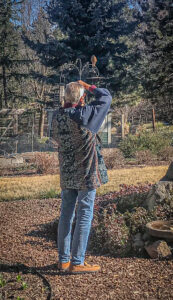
One of the silver linings of this COVID-Chaos is the weekly remote bridge games with Sooney’s sister, Carol, and her hubby, Jim. Our phones connect via FaceTime and we use online BridgeBase for all the rest. Technology has filled an essential social role in the households of so many millions; we know single adults for whom phones, TV, and the Internet are the principal conduit outside their bubbles of one. Who would guess in years past that we’d be having regular card games with family living in Florida. About the only challenging thing is figuring out the different time zones; thankfully we have enough fingers to manage that.
Yesterday’s game had a bit of a twist, however. We had just finished the final hand and were catching up on family news before tuning into the Super Bowl. Suddenly there was a flurry of small bird activity near our feeder and then, in an instant, they were gone. As if settling into a comfortable chair, the neighborhood Sharp-shinned Hawk had landed on the large rock near the feeder, ostensibly looking for a feathery meal. Thrilled to see this beautiful bird again, I excused myself, grabbed my camera, and started shooting. And shooting. And MORE shooting. The bird surprisingly flew down from the rock onto the dwarfed species of Oregon Grape surrounding the rock and we couldn’t figure out what that was all about. It was awkwardly flapping its wings while attempting to find something substantial on which to land. After a moment of fumbling around the woody foliage, it decided the feeder itself was the best vantage point and settled upon it for awhile.
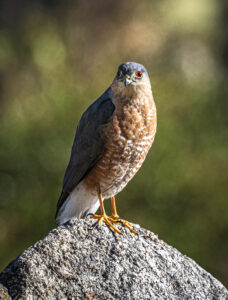
My first couple exposures were through the window for documentation in the event the bird flew. I then quietly opened the slider and kept shooting while slowly (and carefully) walking toward the bird while keeping my eye glued to the viewfinder. I actually got to within 10’ at one point. The hawk was fully aware of my presence and, while wary, didn’t appear to be threatened. It just ignored me—a little preening, periodically gazing down at the feeder in the unlikely event some goldfinch showed up—just hanging out.
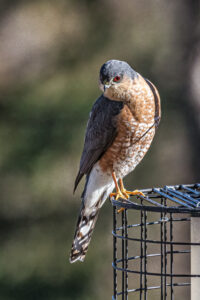
After 10 minutes, I was getting sore holding my position. After 250 exposures (film is cheap, after all), I secretly hoped that it would just leave and, in doing so, allow me a chance for some “takeoff” shots. No such luck. I should have asked Sooney to do her cat-eradication-arm-waving freak dance but she was chatting with friends John and Mary who had happened by while on a walk. It was surreal; they were taking photos of me taking photos, all the while the four of us visiting as if nothing unusual was going on. The bird simply ignored us.
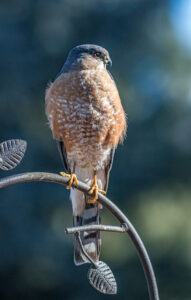
There’s one thing that’s been consistent throughout this year-long Covid confinement. We look forward to a daily regimen of spending an hour or so together outdoors, regardless of the weather, with binoculars and camera part of our costume. The natural beauty of our neighborhood provides us numerous alternatives to hours spent indoors, and we’re grateful having so many engaging walks right outside our door. Today, the natural world came to us, and I’ve shared a gallery of photos documenting the unusual event. I guess the only downside was we eventually lost the rubber. (Uhh, that’s a bridge term.)
Help distinguishing a Sharp-shinned Hawk from a Cooper’s Hawk
Three species of hawks fall into the group known as accipiters: Sharp-shinned, Cooper’s, and Northern Goshawks. Of the 3, the first two are far more commonly seen (and confused) while on our neighborhood walks. The name accipiter implies the habitat in which the birds frequent; dense woods and the edges of forests. The hawk’s short, broad wings enable them to accelerate rapidly, and their long tails are efficient rudders for steering around trees in the pursuit of prey. Their extraordinary mobility in these tight areas makes them voracious hunters of songbirds, their predominant prey.
Sharpies perch quietly in trees (or on our feeder as has recently been the case) and, when prey is sighted, they make a rapid dash after it. Their flap rate is so fast it’s impossible to count. If the intended prey is not caught quickly, the pursuit is dropped after a short distance. When the hawks do get close, they reach out with their long legs and grab the animal with powerful, taloned feet (although I’ve never seen a catch).
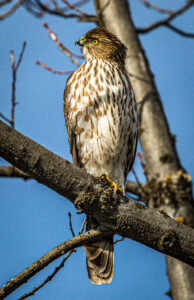
Apparently, there is no single telltale characteristic that can identify either species. Instead, birders need to consider several characteristics of the bird to decide which species it is. Bear in mind that juveniles of both of these accipiters have brown backs and brown stripes (vertical) on their chests. Adults have blue-gray backs and orange barring (horizontal) on their chests. Finally, most raptor ID folks don’t use “smooth” or “curved” or square” anymore when describing the tails of these birds because of the way the feathers fold. They agree that the only real way to tell is with a ventral view so you’re able to see whether there’s a marked graduation in the tail feathers.
[table id=3 /]
You may find it helpful to view my growing compilation of photos of BOTH species. Once there, I’d suggest you click on a thumbnail to view a larger image. You may then sweep through the gallery or use the arrows on your device.
